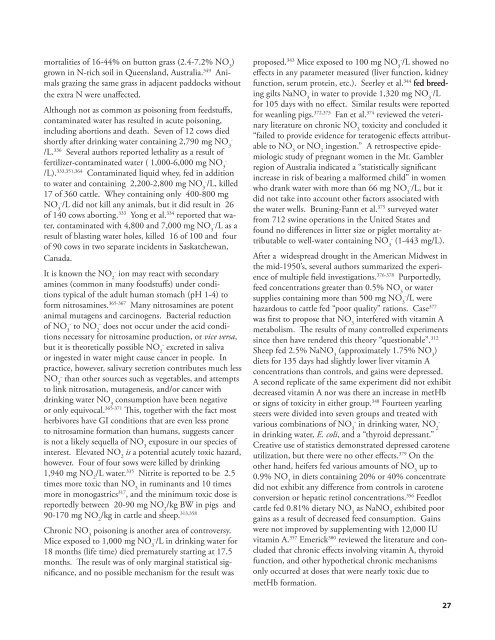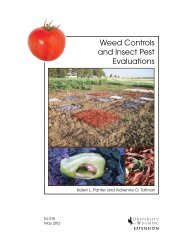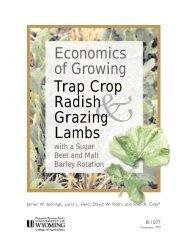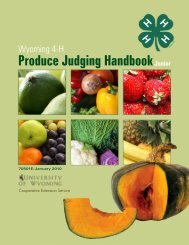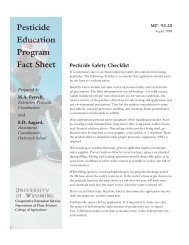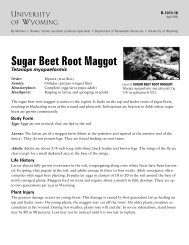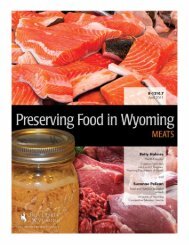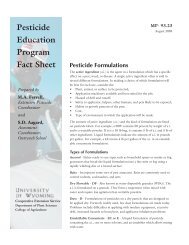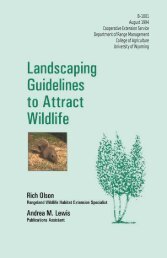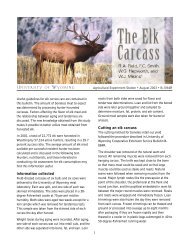not transport oxygen from the lungs to the rest of thebody. The exact mechanism by which Hb is oxidized isthe subject of some controversy but is currently thoughtto be a multi-step autocatalytic process involving severalfree radicals. 328 The end product of this reaction is NO 3-,which is eliminated via urine and saliva. As might beexpected, the clinical signs of acute NO 3poisoning (cyanosis,hyperpnea, muscle tremor, weakness, collapse, anddeath) reflect the effects of anoxia on critical organs suchas the brain and heart. Pregnant animals that surviveepisodes of acute NO 3poisoning during the latter partof pregnancy may abort within one to two weeks. 333,337-340Poisoning during earlier pregnancy does not usually resultin abortion. 313,331,333,341As might be expected from the toxic mechanism, monogastricanimals (with the exception of human infants)seem to be relatively resistant to the effects of NO 3compared to ruminants. Textbooks suggest NO 3isapproximately 10-fold more toxic in ruminants thanmonogastric animals. 317 Burwash et al. 342 fed six mareshigh NO 3(1.7-1.85%) oat hay <strong>for</strong> 13 days. Althoughthe serum NO 3-concentration increased significantly,there was no change in metHb concentration, no effectson blood chemistry parameters, and no clinical signs ofpoisoning. They concluded it is safe to feed horses dietscontaining 2% NO 3and “likely much higher” concentrations.Mice exposed to drinking water containing 1,000mg NO 3-/L <strong>for</strong> 18 months excreted more ammoniumion than controls early in the study and may have diedslightly sooner (17.5 months vs. 18 months) but did notshow any signs of poisoning. 343 Seerley et al. 344 fed watercontaining 1,465, 2,900, or 4,400 mg NO 3-/L as NaNO 3to weanling pigs <strong>for</strong> 84 days with no effect upon rate ofgain, water consumption, or clinical signs of toxicity. Thedifference in toxicity between animal species is not nearlyas pronounced <strong>for</strong> NO 2. 317 Although rare, monogastricanimals have been acutely poisoned by the NO 2-ion fromwater 335 and feedstuffs. 345Wright and Davison 346 reviewed the literature andconcluded the LD 50of NO 3in ruminants was between700-985 mg NO 3/kg BW when fed as dry feed. Experimentally,sheep have been acutely poisoned by NO 3dosesas low as 300 mg/kg BW 323,325,329,347 ; however, doses aslarge as 800 mg/kg BW have been fed without measurableeffects. 323,326,327,340,347,348 Field reports have incriminatedfeedstuffs containing as little as 2% ppm dietaryNO 3(which would provide about 500 mg NO 3/kg BW)as causing acute lethality in sheep . 349,350 Experimentally,3.4% dietary NO 3, fed as pigweed or oat hay killedtwo of five ewes. The lethal dosages, calculated fromconsumption data, were 660 and 730 mg NO 3/kg BW,respectively. Campagnolo et al. 351 reported the accidentalpoisoning of several animals, including sheep, by watercontaining 6,000 mg NO 3-/L at a county fair; however,the water contained several other substances that mightalso have been toxic.Cattle have been experimentally poisoned by 520 mg/kgBW or more NO 3incorporated into feedstuffs 341,346,352,353 ,and as little as 200 mg/kg BW may be toxic if givenby gavage. 354 Several investigators 324,354,355 consistentlyproduced sublethal toxicity with 200-300 mg NO 3/kgBW in order to test various protective strategies. Otherinvestigators 322,356,357 failed to demonstrate toxicity at dietaryconcentrations as high as 0.9% (approximately 225mg NO 3/kg BW), although one 322 reported that sustainedexposure enhanced the ability of the rumen microflorato degrade NO 3-and NO 2-. Calves were experimentallypoisoned by drinking water containing 2,500 mg NO 3-/L (250 mg/kg BW), but none were affected by 2,000or less. 338 Older texts and reviews variously describe theminimum toxic dose in cattle as 169-500 mg NO 3/kgBW. 313,317,358There are numerous anecdotal reports of acute NO 3poisoning in cattle associated with contaminated feedstuffs.O’Hara and Fraser 359 summarized 10 episodes ofacute NO 3poisoning in New Zealand in which mortalityvaried from less than 1% to almost 50%. Forage concentrationsassociated with these cases ranged from 0.3-5.3%NO 3(mean = 3.3%) with variations of 1-2% NO 3betweensamples from the same premise. In one extensivelyinvestigated case, 23 of 50 calves turned into a ryegrasspasture containing 6.6-8.9% KNO 3(4-5.3% NO 3) diedwithin a 12-hour period. 359 In another instance, calvesdied if left on a ryegrass pasture containing 3.6% NO 3<strong>for</strong> more than one hour. 360 A dose of NO 3, later calculatedto be 170 mg NO 3/kg BW, from contaminatedhay killed seven of 200 heifers. The herdsman triedto dilute the toxic hay in half and killed seven more. 361The authors speculated that concurrent overfeeding ofmonensin enhanced ruminal reduction of NO 3-to NO 2-,thus potentiating the toxicity of the hay. Harris andRhodes 362 , summarizing the experience of farmers duringa severe drought in Victoria, Australia, reported severalhundred animals were killed by plants containing “over1.5% NO 3.” Three cows fed hay containing 1% NO 3died within 30 minutes. 353 Eleven cows aborted, and 73of 153 died when fed sudax hay containing 1.1-3.1%NO 3. 363 McKenzie summarized several cases with acute26
mortalities of 16-44% on button grass (2.4-7.2% NO 3)grown in N-rich soil in Queensland, Australia. 349 Animalsgrazing the same grass in adjacent paddocks withoutthe extra N were unaffected.Although not as common as poisoning from feedstuffs,contaminated water has resulted in acute poisoning,including abortions and death. Seven of 12 cows diedshortly after drinking water containing 2,790 mg NO 3-/L. 336 Several authors reported lethality as a result offertilizer-contaminated water ( 1,000-6,000 mg NO 3-/L). 333,351,364 Contaminated liquid whey, fed in additionto water and containing 2,200-2,800 mg NO 3-/L, killed17 of 360 cattle. Whey containing only 400-800 mgNO 3-/L did not kill any animals, but it did result in 26of 140 cows aborting. 333 Yong et al. 334 reported that water,contaminated with 4,800 and 7,000 mg NO 3-/L as aresult of blasting water holes, killed 16 of 100 and fourof 90 cows in two separate incidents in Saskatchewan,Canada.It is known the NO 2-ion may react with secondaryamines (common in many foodstuffs) under conditionstypical of the adult human stomach (pH 1-4) to<strong>for</strong>m nitrosamines. 365-367 Many nitrosamines are potentanimal mutagens and carcinogens. Bacterial reductionof NO 3-to NO 2-does not occur under the acid conditionsnecessary <strong>for</strong> nitrosamine production, or vice versa,but it is theoretically possible NO 2-excreted in salivaor ingested in water might cause cancer in people. Inpractice, however, salivary secretion contributes much lessNO 2-than other sources such as vegetables, and attemptsto link nitrosation, mutagenesis, and/or cancer withdrinking water NO 3consumption have been negativeor only equivocal. 365-371 This, together with the fact mostherbivores have GI conditions that are even less proneto nitrosamine <strong>for</strong>mation than humans, suggests canceris not a likely sequella of NO 3exposure in our species ofinterest. Elevated NO 2is a potential acutely toxic hazard,however. Four of four sows were killed by drinking1,940 mg NO 2/L water. 335 Nitrite is reported to be 2.5times more toxic than NO 3in ruminants and 10 timesmore in monogastrics 317 , and the minimum toxic dose isreportedly between 20-90 mg NO 2/kg BW in pigs and90-170 mg NO 2/kg in cattle and sheep. 313,358Chronic NO 3poisoning is another area of controversy.Mice exposed to 1,000 mg NO 3-/L in drinking water <strong>for</strong>18 months (life time) died prematurely starting at 17.5months. The result was of only marginal statistical significance,and no possible mechanism <strong>for</strong> the result wasproposed. 343 Mice exposed to 100 mg NO 3-/L showed noeffects in any parameter measured (liver function, kidneyfunction, serum protein, etc.). Seerley et al. 344 fed breedinggilts NaNO 3in water to provide 1,320 mg NO 3-/L<strong>for</strong> 105 days with no effect. Similar results were reported<strong>for</strong> weanling pigs. 372,373 Fan et al. 374 reviewed the veterinaryliterature on chronic NO 3toxicity and concluded it“failed to provide evidence <strong>for</strong> teratogenic effects attributableto NO 3or NO 2ingestion.” A retrospective epidemiologicstudy of pregnant women in the Mt. Gamblerregion of Australia indicated a “statistically significantincrease in risk of bearing a mal<strong>for</strong>med child” in womenwho drank water with more than 66 mg NO 3-/L, but itdid not take into account other factors associated withthe water wells. Bruning-Fann et al. 375 surveyed waterfrom 712 swine operations in the United States andfound no differences in litter size or piglet mortality attributableto well-water containing NO 3-(1-443 mg/L).After a widespread drought in the American Midwest inthe mid-1950’s, several authors summarized the experienceof multiple field investigations. 376-378 Purportedly,feed concentrations greater than 0.5% NO 3or watersupplies containing more than 500 mg NO 3-/L werehazardous to cattle fed “poor quality” rations. Case 377was first to propose that NO 3interfered with vitamin Ametabolism. The results of many controlled experimentssince then have rendered this theory “questionable”. 312Sheep fed 2.5% NaNO 3(approximately 1.75% NO 3)diets <strong>for</strong> 135 days had slightly lower liver vitamin Aconcentrations than controls, and gains were depressed.A second replicate of the same experiment did not exhibitdecreased vitamin A nor was there an increase in metHbor signs of toxicity in either group. 348 Fourteen yearlingsteers were divided into seven groups and treated withvarious combinations of NO 3-in drinking water, NO 2-in drinking water, E. coli, and a “thyroid depressant.”Creative use of statistics demonstrated depressed caroteneutilization, but there were no other effects. 379 On theother hand, heifers fed various amounts of NO 3up to0.9% NO 3in diets containing 20% or 40% concentratedid not exhibit any difference from controls in caroteneconversion or hepatic retinol concentrations. 356 Feedlotcattle fed 0.81% dietary NO 3as NaNO 3exhibited poorgains as a result of decreased feed consumption. Gainswere not improved by supplementing with 12,000 IUvitamin A. 357 Emerick 380 reviewed the literature and concludedthat chronic effects involving vitamin A, thyroidfunction, and other hypothetical chronic mechanismsonly occurred at doses that were nearly toxic due tometHb <strong>for</strong>mation.27
- Page 1 and 2: Water Qualityfor Wyoming Livestock
- Page 3: AbbreviationsADG - average daily ga
- Page 6 and 7: 7 pH 31Function. . . . . . . . . .
- Page 8 and 9: animal drinks. Water intake is tech
- Page 10 and 11: ter or “mg X/L”. If the substan
- Page 12 and 13: tion between the erythrocytic and p
- Page 14 and 15: in diseases such as cancer. 10,20,2
- Page 17 and 18: 3 BariumBarium (Ba), an alkaline ea
- Page 19 and 20: exposed to 100 mg Ba 2+ /L had depr
- Page 21 and 22: 4 FluorideFluorine (F) is the most
- Page 23 and 24: lost weight and many died at the hi
- Page 25: Our search of the literature pertai
- Page 28 and 29: elatively stable; however, once unb
- Page 30 and 31: supplementing with 17 ppm Cu for si
- Page 34 and 35: Winter and Hokanson 381 fed varying
- Page 37 and 38: 7 pHpH is defined as “the negativ
- Page 39: for basic drinking water. From a pu
- Page 42 and 43: efficiency. 436,437 Absorption of S
- Page 44 and 45: significantly impaired in the same
- Page 47 and 48: 9 Sodium ChlorideSodium chloride (N
- Page 49 and 50: containing 15,000 mg NaCl/L for 21
- Page 51 and 52: 10 SulfurSulfur (S) occurs in natur
- Page 53 and 54: in feed or water consumption. The a
- Page 55 and 56: 11 Total Dissolved Solids (TDS)Tota
- Page 57: 12 SummaryElementShort (days - week
- Page 61 and 62: 14 Bibliography1. National Research
- Page 63 and 64: 35. Klug H.L., Lampson G.P. and Mox
- Page 65 and 66: 69. Harding J.D., Lewis G. and Done
- Page 67 and 68: 104. Choudhury H. and Cary R. (2001
- Page 69 and 70: 136. Boyd E.M. and Abel M. (1966).
- Page 71 and 72: 171. Mullenix P.J., Denbesten P.K.,
- Page 73 and 74: 203. Schultheiss W.A. and Van Nieke
- Page 75 and 76: 237. Tolgyesi G. and Elmoty I.A. (1
- Page 77 and 78: 269. ANZECC (2000). Australian and
- Page 79 and 80: 301. Huber J.T., Price N.O. and Eng
- Page 81 and 82: 332. Crowley J.W., Jorgensen N.A.,
- Page 83 and 84:
366. Walker R. (1990). Nitrates, ni
- Page 85 and 86:
399. Wu L., Kohler J.E., Zaborina O
- Page 87 and 88:
432. Naftz D.L. and Rice J.A. (1989
- Page 89 and 90:
464. Glenn M.W., Jensen R. and Grin
- Page 91 and 92:
498. Knott S.G. and McCray C.W.R. (
- Page 93 and 94:
532. Harvey R.W., Croom J. WJ, Pond
- Page 95 and 96:
567. Koletsky S. (1959). Role of sa
- Page 97 and 98:
602. Gooneratne S.R., Olkowski A.A.
- Page 99 and 100:
633. McAllister M.M., Gould D.H., R


